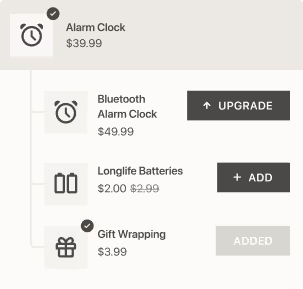Update (November 2025): Shopify added a new product status called "unlisted" which is a perfect solution for hiding out-of-stock products. See the second option for more details.
One of the essential things to run a successful online business is managing inventory. You need to forecast to make sure your most popular products are always in stock. But what about those which are sold less often and sometimes become out of stock?
You definitely don't want to display sold-out products at the top of your collections, and neither drive any campaign traffic to their product pages.
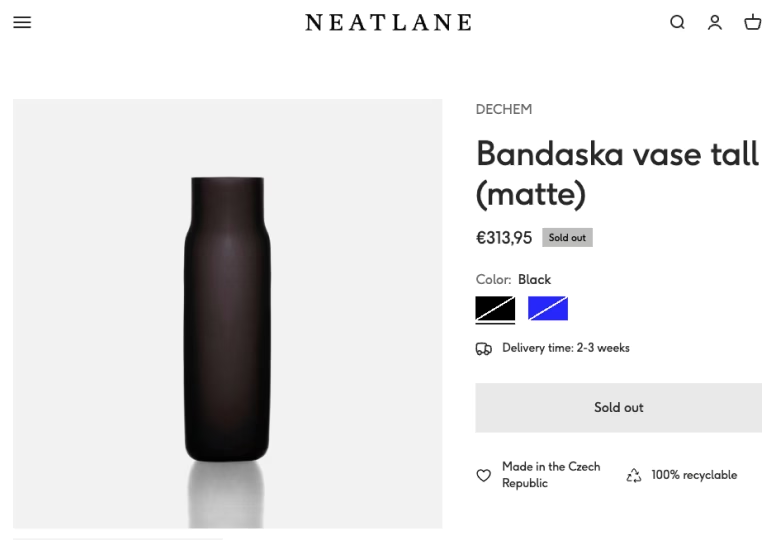
The best way to handle sold-out inventory is to either hide it entirely or at least push it to the bottom of your collections. This guide will explore the first approach and learn how to hide products and their variants.
Option #1: Use a third-party app
Several third-party apps can help you with managing your store inventory. Our recommendation is an app called Nada: Sort & Hide Out-of-Stock.
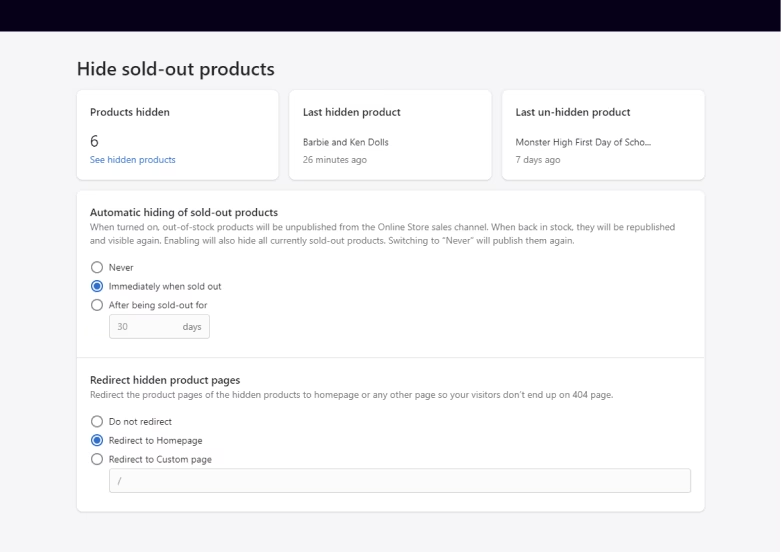
Nada: Sort & Hide Out-of-Stock automatically hides sold-out products by unpublishing them from the Online Store sales channel. But it also automatically puts them back online when they are available. On top of that, it creates redirects, so there are no 404 errors. So it essentially removes the disadvantages from option #2, #3, and #5.
The app starts at only $0.99 for the first month, and you can take advantage of a 7-day free trial.
Other apps to try:
For more options, check out the list of the best Shopify apps for hiding sold-out products.
Option #2: Set product as unlisted
In October 2025, Shopify introduced a new product status called "unlisted". The unlisted status means the product is not visible on the storefront and store search, but still fully accessible (and purchasable) through the URL.
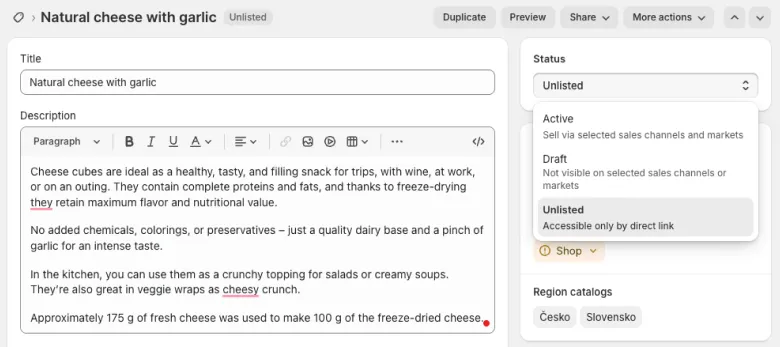
That is almost perfect for hiding the sold out products or free gifts because customers won't see them, and search engines can still access the URL.
To set the product as unlisted, follow these steps:
- Go to your product catalog and open the particular product
- Change the status to "Unlisted" and click on Save
- And the product is now hidden to customers browsing your store
But this solution is not bulletproof and still have couple of risks:
- The URL is still indexed by search engines and LLMs (i.e., ChatGPT) which can send you organic traffic, unless you manually disable indexing via robots.txt
- The product is still published on other sales channels like Facebook and Google, as one Redditer learned
- You need to change the status manually or setup a Flow
Option #3: Unpublish product from the sales channel(s)
Probably the easiest way to hide the product from your Shopify store is by unpublishing from a particular sales channel. In the case of an online store, the default channel name is Online Store (surprisingly).
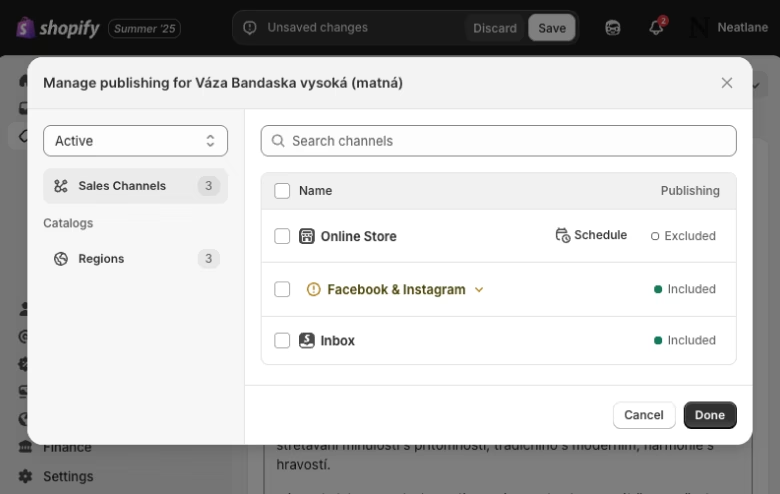
To unpublish the product from the sales channel, follow these steps:
- Go to your product catalog and open details of a particular product
- In the top-right corner, click on Manage in the SALES CHANNELS AND APPS section
- Uncheck the desired channel, click Done, and Save
- And the product is hidden, and no one can purchase it anymore
Besides hiding the product from the storefront, it will also be hidden from a site search.
However, you need to keep in mind the disadvantages which are:
- Returning 404 error on the product page (Google doesn't like that at all!). It can be resolved via custom redirects
- It can be time-consuming in the case of dozens of products that you need to unpublish and republish again. Product import & export can save a lot of time
Option #4: Set product status to draft
It is similar to option #1 with the difference that once the product is set to draft, it's not visible and is not purchasable at all channels. Disadvantages are the same.

To set the product status to draft, follow these steps:
- Go to your product catalog and open details of a particular product
- In the top-right corner, in the Status section, click on Active drop-down and change it to Draft
- Click on Save, and the product is hidden everywhere
Option #5: Set automatic collection rules
If you are using automatic collections, you can add a condition to display only products that are in stock. The significant advantages compared to the previous two methods are:
- No 404 errors (product pages are still accessible through direct links)
- No manual work, everything is automatic, and the product will become visible once it's available again
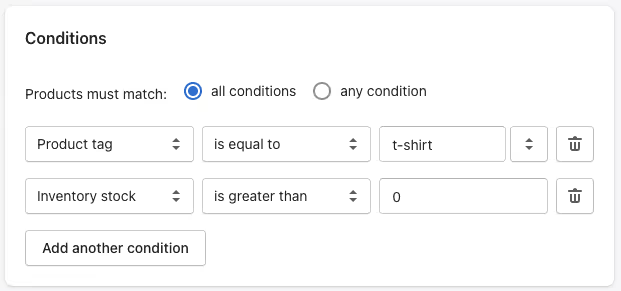
To set the inventory stock condition follow these steps:
- Go to your Shopify store admin > Products > Collections
- Select a particular collection, and in the section Conditions click on Add another condition. If you don't see Conditions section that means the collection is not automatic, but manual
- From the drop-down select Inventory stock + is greater than + 0
- Click on Save and that's all. The product will no longer be visible in your collection pages (i.e. yourstore.com/collections)
The disadvantage is that it doesn't work with manual collections, and it doesn't apply to site search.
Option #6: Create automatic rules in Shopify Flow
Shopify Flow is an automation app built by Shopify which allows you to create simple workflows using the IF, THEN, and OTHERWISE rules. It works similarly to Zapier or Make. Once you add the app to your store you can start building your own workflows, or you can browse the public collection which has over 160 shared flows. For hiding and republishing products, the flow is called "Hide and republish products based on inventory level".
The main advantage is the automation and customization. But hiding of the product happens without a redirect, so any visitor of the product page will get a 404 error.

Luckily, Shopify Flow is now available for all Shopify merchants including the ones using Shopify Basic plan.
Bonus: Hiding sold-out variants only
The challenge is how to hide only a particular variant on the product page – not a whole product. Unfortunately, all options above work only when the whole product is sold out (i.e., all its variants).
It doesn't work if you want to hide a particular variant from a selector on your product page. Shopify platform doesn't allow a product variant to be unpublished or set to draft.

Hiding sold-out variants on the Dawn theme
If you are using Dawn (or similar 2.0 theme), you are lucky because you can hide the sold-out variant using a bit of custom CSS.
- Go to your store admin > Online store > Themes > Customize
- Go to product detail page template and select the "Product information" block in the left template menu
- Scroll down to Custom CSS and add following code:
.product-form__input .disabled + label {
display: none;
}The result should look like this.
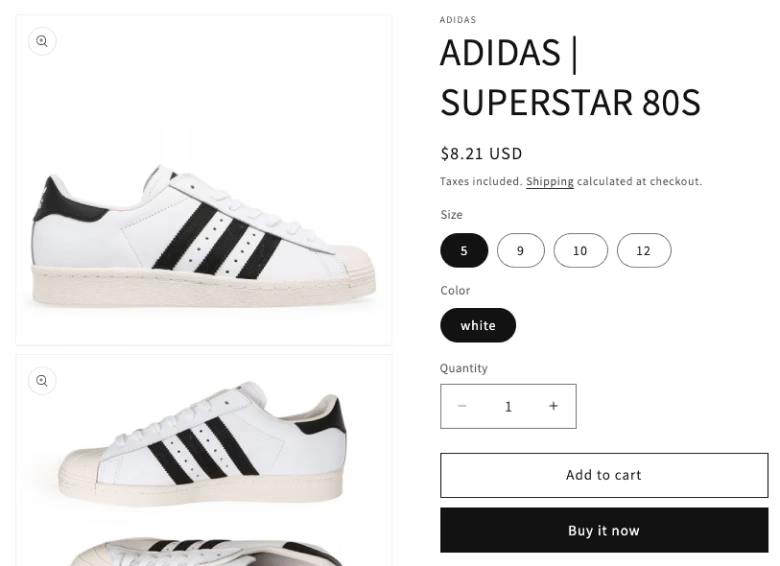
Hiding sold-out variants on the Horizon theme
If you are using a modern theme like Horizon announced at the Editons Summer 2025, the custom CSS unfortunately won't work because the sold-out variants don't have a CSS class.
So you'll need to edit the liquid code of your theme which requires a bit of technical knowledge.
- Go to your store admin > Online store > Themes > ... > Edit code
- Find a file called "variant-main-picker.liquid"
- Find the <label> element and insert condition {% if product_option_value.available %} above it
- Find the closing </label> element and insert {% endif %} below it
Your code should look like this.

The condition will make sure that if the variant isn't available for sell, it won't be displayed on the product detail page.
If you are not able to adjust the custom CSS yourself or you are using a different theme, feel free to contact us, and our agency team will be happy to look into it.












